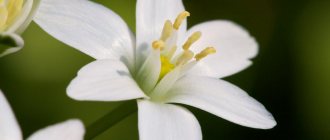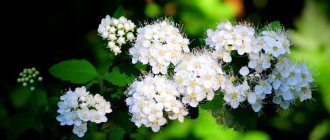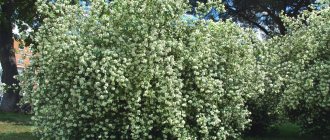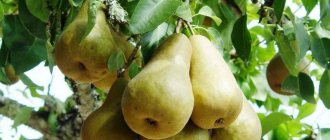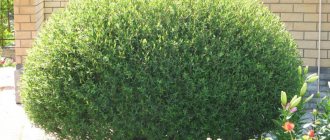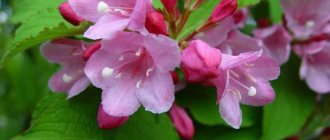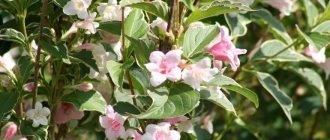Description of appearance
- The leaves are oval-shaped, located opposite each other on the shoots. The lower part of the leaf is usually not much pubescent.
- Inflorescences in the form of a brush can form both in the axils of the upper leaves and on the tops of the shoots.
- The flowers are simple in shape with 4 – 5 petals, large, up to 7 cm in diameter. The color of the flowers is white or with a cream tint.
Flowering mock orange became widespread in Russia back in the 16th-17th centuries. It was grown in the gardens of the king and boyars.
Some species are very winter-hardy and can withstand temperatures down to – 25C. For most varieties, already - 15C is the limit of possibilities, and they can freeze to snow cover. However, this does not harm the bush; it will grow back in the spring.
This is interesting: mock orange trunks are hollow inside. Previously, pipes and smoking pipes were made from them.
What is mock orange and how does it grow?
The Latin name of the mock orange, Philadelphus, comes from the Greek words “love” and “brother”, because the shoots of the bush are located opposite and close to each other. According to another version, the name of the deciduous shrub was given in honor of one of the kings of Ancient Egypt, Ptolemy Philadelphus.
Mock orange belongs to the Hydrangeaceae family. Botanists know more than 60 species of this plant growing in the wild. No more than half of all varieties of garden jasmine are cultivated.
What does mock orange look like?
All types of mock orange are similar in basic parameters. These are shrubs ranging in height from one to three meters with closely spaced opposite shoots. Its leaves are roundly elongated, sometimes pointed, small (5 - 7 cm), more often smooth, but also have jagged edges.
The bark of the plant is predominantly gray. In some types of jasmine it is brownish. In most varieties, the bark darkens on the shoots of the second year of life. For some completely, for others only at the base. The bark peels off on mature shoots.
Flowering of garden jasmine begins in late spring and lasts from a month to two. Its flowers are simple, white, from two cm in diameter, collected in inflorescences from 3 to 9 pieces, bloom on short side branches of the shoot. Most types of mock orange, or garden jasmine, as it is often called, have a delicate aroma. But there are also species without odor. In varietal hybrid varieties, the inflorescences can consist of double flowers and reach a size of more than 10 cm.
Blooming mock orange (jasmine) photo:
The mock orange fruit is not large. The capsules, consisting of several chambers, are filled with small achenes.
In nature, mock orange grows in regions with warm and temperate climates (north of the American continent, East Asia, Europe). The culture prefers the edges of deciduous or mixed forests. It is often found on rock slides and cliffs. Bushes grow one by one or in groups.
How fast does mock orange grow?
Gardeners classify garden jasmine as a fast-growing shrub. It only takes 2 - 3 years from the moment of planting for the height and size of the mock orange crown to reach the maximum for its variety.
Application of mock orange
Jasmine is universal in landscape design. Single bushes perfectly decorate garden gazebos and look original against the background of brick and stone walls of a house and other buildings. Due to the rapid growth of shoots, mock orange is suitable for creating hedges of various heights.
Photo of a single planting of a mock orange bush:
The most famous varieties of garden jasmine
Many varieties and hybrid forms have been bred by foreign and domestic breeders, photo.
Mock orange crown
Chubushnik crown is a tall shrub, up to 3 meters high. The flowers are white, with a strong aroma. Retains the ability to flower up to 30 years of age. Frost-resistant, can withstand temperatures down to – 25C.
Minnesota Snowflake (snowflake)
Minnesota mock orange is frost-resistant. Large double flowers, with narrow petals, look like a wet snowflake. This appearance gave rise to the name of the variety.
Pearl
The “Pearl” variety is the fruit of Russian breeders. It is small in size. The flowers are large, up to 7.5 cm in diameter, with the scent of vanilla.
Blizzard
Terry mock orange, about 1 meter high. This is a highly decorative variety. Numerous flowers are formed at the ends of short branches, so they are arranged quite densely. It seems that the plant was caught in a snow storm.
Lemoine's mock orange is the result of the work of the French company after which it received its name. Popular varieties of this group.
Ermine Robe
Mock orange Ermine mantle is a low-growing shrub, no higher than 80 cm in height. On thin, hanging shoots there are miniature narrow leaves. The flowers are half double with narrow petals and exude the scent of strawberries. One of the longest and most abundantly flowering varieties.
Chubushnik Snowbel (Snow Beauty)
Mock orange Snowbel reaches a height of 3 meters, the shoots are erect with large, 7-centimeter leaves. Double flowers with a strong, pleasant aroma.
This is interesting: the snow beauty has an interesting property - it alternates the formation of double and regular flowers with a frequency of once every 2 years.
Varieties of crown mock orange (Philadelphus coronarius)
In the middle zone, the crown mock orange blooms first - in early June (if the spring is warm, then at the end of May). This shrub grows quite quickly and can reach a height of 3 m. The plant lives for about 30 years. The most commonly cultivated ornamental varieties in gardens are:
Aureus
In spring, this shrub with a spherical crown is decorated with bright yellow leaves, and in summer and autumn they are yellowish-green. Thanks to its bright foliage, this mock orange is decorative all season, and not just during flowering, when it is covered with numerous simple white flowers with yellow stamens in the center, emitting a strong aroma. Mock orange Aureus grows well in sunny areas, and tolerates partial shade, but then blooms sparingly. After flowering it needs sanitary pruning.
Variegatus
This upright shrub reaches a height of 1.5 m. In addition to creamy-white fragrant flowers, it has very attractive slightly serrated leaves (up to 5-9 cm long) of variegated (and some completely white) colors.
Conditions for keeping mock orange
Garden jasmine is grown only in open ground; it requires a cold winter.
Requirements for the planting site, soil composition
The plant is famous for its unpretentiousness; caring for it is simple:
- The shrub prefers open, bright spaces, where it will grow for up to 25 - 30 years. It can grow in partial shade, but the number of buds and flowering duration will be lower.
- It is not picky about the composition of the soil, with the exception of places with poor drainage. Mock orange does not tolerate stagnant water or waterlogging of the soil.
Any cultivated soil with a universal composition is suitable for it: garden soil, peat, leaf humus, compost, in equal proportions. On loamy soils, additional drainage may be required: pebbles, expanded clay.
Fertilizing, watering
Regular watering is required, avoiding drooping of the leaves. Lack of moisture negatively affects flowering.
Feed the bushes twice a year:
- In early spring, fertilizers containing nitrogen are used: urea, slurry solution.
- At the end of flowering: superphosphate and potassium sulfate, in the dosage recommended by the manufacturer.
Planting, transplanting, care
The most successful period for planting and replanting garden jasmine is autumn (from early September to the first half of October). In spring it is a little more difficult - you need to have time to plant the bush before the buds open. If you plant several mock oranges at once, the distance between them should be from 50 cm to 1.5 m; when planning a hedge, place the bushes at a distance of 50–80 cm.
It is advisable to prepare the hole about 14 days before planting - dig a hole up to 70 cm deep, lay a drainage layer (up to 15 cm) of broken brick or coarse sand on the bottom, and pour the same layer of soil mixture on top.
When planting a seedling, only the root is placed in the ground; the stem from the root collar must remain on the surface, otherwise there is a risk of rotting. After planting, the seedling needs to be watered generously and after a couple of days mulched with a small layer (3–4 cm) of sawdust or peat.
Important! The maximum depth of the root collar into the ground should not exceed 3 cm.
Another useful observation is that mock orange does not like to be adjacent to an apple tree; they have a suppressive effect on each other (allelopathy effect). For many years we wondered why our bush did not grow widely and threw up something resembling tops that bloomed poorly at the very tips. When we decided to replant the bush, everything immediately got better - it blooms well and fluffs up. So don’t go wrong with your choice of landing site. Here he is in the second year of transplantation:
How to care for garden jasmine
Watering.
All types of garden jasmines are sensitive to drought; it is advisable to water them once a week with 2-3 buckets of water per bush. In particularly hot periods and during flowering, daily watering may be required; watch the leaves, they will droop from lack of moisture.
Many gardeners recommend periodically loosening the soil, here it is better to go the other way and mulch the tree trunk circles, this way you will solve several problems at once - reduce the frequency of watering, and eliminate the need for weeding and loosening.
Fertilizers.
In spring, it is recommended to feed the kutas with slurry (no more than 1 bucket in a ratio of 1:10). After flowering, wood ash will help restore strength; just scatter it around the perimeter of the tree trunk before watering.
Trimming.
The first procedure is carried out almost immediately after planting; remove weak branches and slightly shorten the main shoots. After flowering, all weak branches should be cut off, thereby allowing new shoots to develop.
In autumn, side branches form on new branches, which will bloom the following year. In the 3rd year, the young branches will get stronger, and so that they do not lose strength and bloom profusely, the old branches can be cut off to the base. Anti-aging pruning is carried out in early spring (before sap flow begins), sanitary pruning - in autumn. It is not necessary to treat the cut areas with garden varnish; the bark will dry out underneath it.
Important! When pruning, remember: mock oranges bloom on last year’s strong shoots.
Transfer.
Based on our experience, mock orange easily tolerates a change of location, but in the first year after transplantation, the bush most likely will not bloom. To begin with, prepare a hole in a new place (as in the case of planting), then proceed to prepare the bush - a day before replanting, water the bush generously, after a day half of the old shoots should be removed to the roots, the rest should be shortened by half - that's it, the bush is ready for transplantation The period of transplantation and planting is the same.
Diseases and pests.
Garden jasmine is resistant to disease, but the most dangerous pests are the green leaf weevil, spider mite and bean aphid. For protection, use folk recipes or biological products.
Mock orange blossom
Mock orange is grown in gardens for its beautiful flowers, which frame the plant like a bridal veil.
The start of flowering varies depending on the variety and lasts about 20 – 25 days.
In some cases, it stops forming buds, there are reasons for this:
- Age of the seedling. Bushes grown from cuttings bloom in 4–5 years. Seedlings from seeds will have to wait 7–8 years for flowering.
- Shadow. With a lack of lighting, the plant produces fewer buds.
- Severe freezing. This is a temporary phenomenon - after the growth of new shoots, flowering will resume.
- Excessive spring pruning.
Rules for cutting and forming a bush
To maintain a neat appearance and prevent thickening of the bush, the plant requires pruning. It comes in several types:
- Sanitary pruning. Weak, damaged branches, as well as shoots directed into the bush, must be removed. It can be carried out at any time of the year.
- Anti-aging pruning. Old branches older than 10-12 years are cut at the root. This procedure stimulates the formation of new shoots.
- Formative pruning of mock orange is carried out after flowering has ended. Faded shoots and green tops are removed to the level of lignification. Some varieties are shaped like a ball.
The first pruning of young plants is carried out after planting them in open ground. Only 2 - 3 branches are left, the rest are cut out.
Circumcision
The shrub grows quickly and erratically, requiring regular pruning. The procedure begins strictly after the start of flowering, because flowers form on shoots no younger than two years old, and excessive removal of such branches will spoil the appearance of the plant.
Branches with weak inflorescences and painful-looking branches are cut off by about a third of their length. When choosing a cut location, pay attention to the location of the upper bud. Choose a place so that the top bud is directed not to the center of the plant, but to its outer part, to prevent their growth into the bush.
Every few years it is worth carrying out thinning sanitary pruning, removing the oldest, thickest branches to rejuvenate the plant.
If you follow the simple principles stated above when pruning, then the shrub in your garden will look as attractive as in the photo of a mock orange from professional greenhouses.
Reproduction of mock orange
False jasmine reproduces easily and has good survival rate.
Cuttings
Propagation by cuttings is carried out in early summer.
Algorithm of actions:
- Green shoots are cut into pieces 8–10 cm long, the leaves are shortened by half.
- In partial shade, prepare a bed with the following soil composition: humus, turf soil, sand in equal proportions.
- Cuttings of cuttings are treated with a growth stimulator, then planted at a slight slope, to a depth of 1 cm.
- The soil is compacted, the cuttings are covered with glass or a plastic bottle. Sun protection should be provided.
- Plantings are ventilated daily. Rooting takes 2 - 3 weeks.
During the first winter, young plants will need shelter. In early spring, the first pruning is carried out at a level of 10–15 cm.
Propagation by seeds
This method is used more often by breeders. The seeds are pre-stratified in a cool place for 1.5 - 2 months. Since the seeds are very small, they are mixed with sand and scattered over the surface of the soil.
Picking is carried out in the phase of 4 true leaves. Planting seedlings in open ground is done in the spring, protecting them from the bright sun.
Root growth
With this method, you should carefully separate some of the young shoots with roots and plant them in a permanent place.
Watering and fertilizing
In the first year of life, the plant needs to be watered regularly, but older plants cope well on their own due to their developed root system.
However, during summer droughts, when the weather is hot for a long time, the plant can be helped to avoid its withering. Monitoring the condition of its leaves helps you figure out how to water a shrub.
Due to this self-sufficiency of the plant, it does not particularly need fertilizing, but to stimulate long-term flowering, it is permissible to apply universal fertilizer at the very beginning of spring.
Diseases and pests
Of the pests, false jasmine is most susceptible to damage by aphids and hawthorn butterfly caterpillars. The following drugs have proven themselves well as control measures: Actelik, Iskra, Intavir.
The leaves are affected by fungal diseases - spots. Good prevention is to remove fallen leaves and spray with fungicides.
Mock orange combines remarkable properties - high decorativeness and ease of maintenance. Therefore, he firmly settled in the hearts and plots of gardeners.
Reviews from gardeners about mock orange
Many summer residents willingly share their enthusiastic opinions about this unusual, interesting, fragrant culture. The plant is very beautiful, creates shade for a hot day, is easy to care for, and does not require much attention. The main thing is to choose a sunny, not swampy place, water regularly and prune the bush in a timely manner. The main disadvantages are the low resistance of some varieties to frost and the difficulty of crown formation.
The shrub needs formative pruning
Ballet of Moths, Ermine Robe, Moonlight, Pearls and others - the poetic names alone make it worth planting mock orange on your property. It is not very whimsical, but it serves as an original decoration for the garden. There are many varieties of crops, which allows you to choose the most suitable variety specifically for your garden plot.


